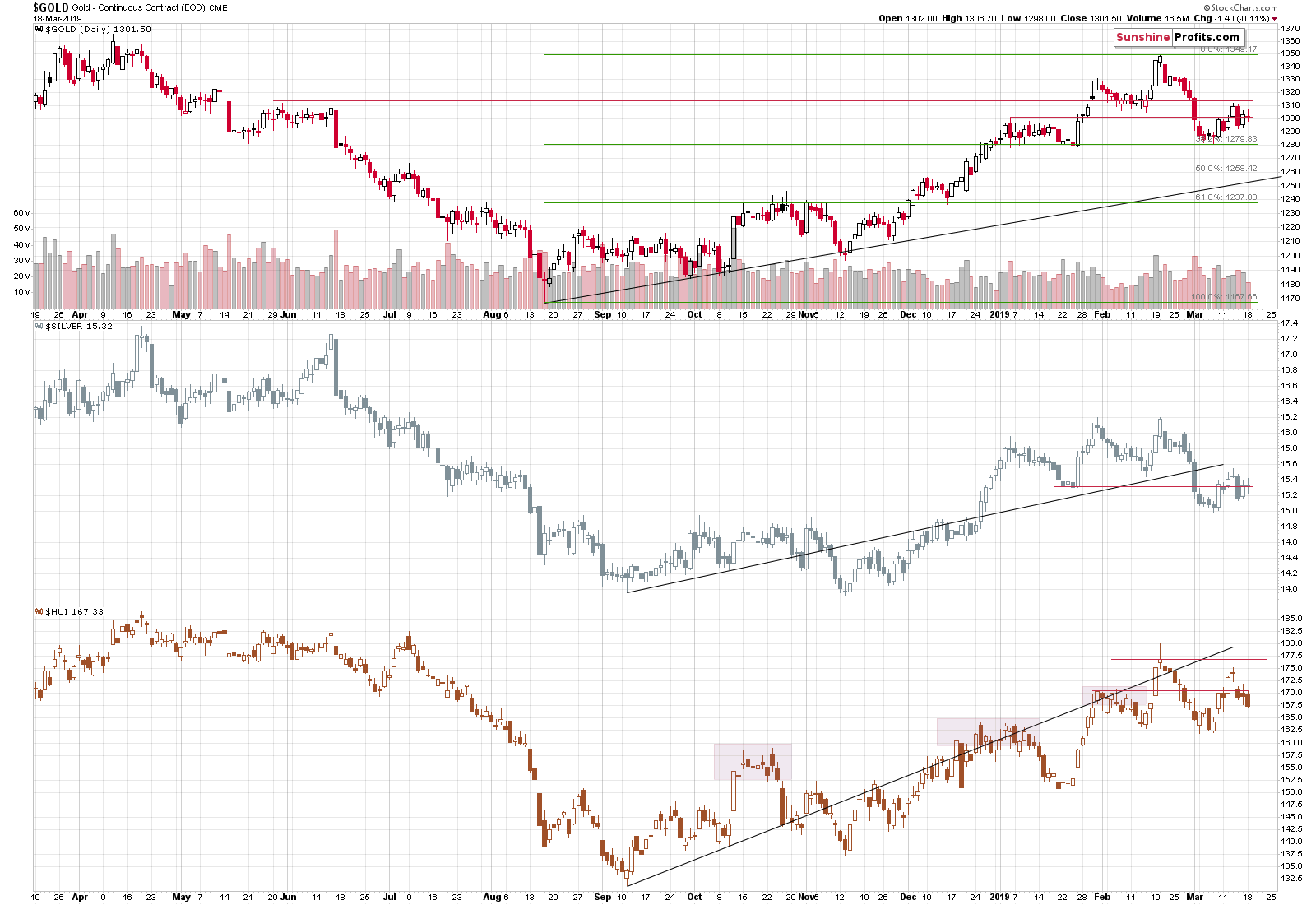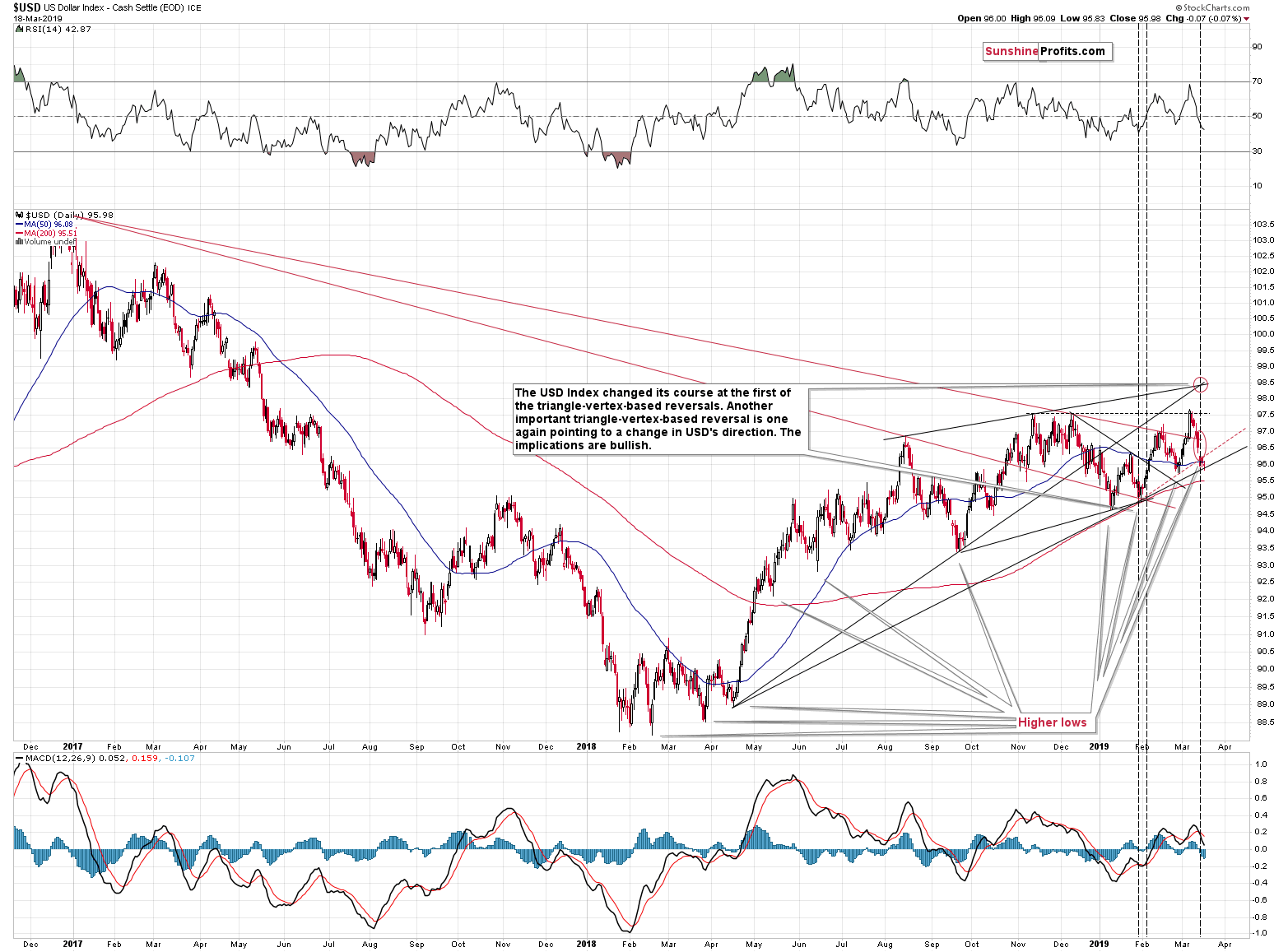Briefly: in our opinion, full (250% of the regular size of the position) speculative short position in gold, silver, and mining stocks is justified from the risk/reward perspective at the moment of publishing this Alert.
Gold stocks declined once again yesterday despite the lack of meaningful declines in gold or silver. Seems miners simply can’t wait to move to lower values just like we indicated previously. Even those that pointed to Stochastics’ recent buy signal have to agree to the bearish interpretation now as the latter flashed a sell signal once again. Miners’ underperformance of gold is never a bullish sign and at this time it provides a screaming confirmation of the point that we made yesterday. Namely, the miners provide the critical sign that clearly shows what’s likely to happen next.
Let’s take a look at the details.
The Silent Scream
Gold and silver have barely done anything yesterday despite some intraday moves up and down. The mining stocks, however, moved lower, and they stayed lower despite the default mode that would have miners end the session close to the previous closing price. Instead of following gold and silver, which would have been the default reaction, mining stocks closed the session lower, which is a significant bearish indication. Our yesterday’s comments on the above chart are not only up-to-date – they are more than confirmed:
The thing is that gold miners should have rallied given gold’s upswing and they didn’t. The HUI Index even declined a bit. The size of the decline is not important – the lack of rally given gold’s $7 upswing is. This is a bearish sign and – more importantly – a factor that clearly differentiates the current situation from the late-January performance.
On March 7, when the HUI was right after the move to new monthly lows, we wrote the following:
The HUI also closed below the declining medium-term support/resistance line, which appears to be a major development. But…
Despite all the extremely bearish signs for the following months, we are still skeptical about the very short-term price moves. You see, we saw almost exactly the same thing recently. In mid-January, gold miners closed a bit above the 50-day moving average after a volatile decline. Then they paused for 2 days and then declined below the 50-day MA. That seemed to be a beginning of another move lower, but it actually turned out to be a local bottom. That was also the time when we saw a small move lower below the declining red support/resistance line that we see on the above chart.
Consequently, while the medium term is clearly and extremely bearish, the next several days could still see higher prices. We don’t expect any major move up – definitely not above the recent highs – but a comeback to the early February highs in the miners might still be in the cards.
The HUI Index moved a bit above the early February highs, but – what is much more important - it didn’t move above the mid-February highs. The move above the February highs, however, might have caused concerns about the bearish nature of the move. After all, the move was quite sizable on a very short-term basis. The subsequent decline might have appeared as a quick correction within a rally that didn’t change much.
The important thing about Friday’s performance is that it was a second day when the miners declined, which was also a weekly close which partially confirms that the move lower was more than a correction within an upswing. The fact that miners just refused to move higher despite gold’s and silver’s upswing is a clear confirmation that in fact it was the recent upswing that was a correction by itself and the downswing was a return to normalcy, not the other way around. It may seem odd that a session, when miners have done anything in terms of the closing prices was so meaningful, but that actually was the case.
The second factor that confirms the bearish nature of the recent moves in the PMs is the situation in the USD Index.
The latter is an important sign also today.
USD Index Resting At Multiple Supports
The USD Index just moved to the final of the short- and medium-term support lines and reversed after reaching it. It seems that the local bottom for the USDX is in. There was no new intraday low, but the strong support was just reached, so what we wrote yesterday, remains up-to-date:
The USDX had previously moved to our target area and then just declined a little bit more. That’s not a serious breakdown as there are strong support levels just below and the above doesn’t change a lot for the USD itself. It was yet another higher low that fits the overall bullish picture for the medium term.
We see more interesting implications in case of the gold-USD link. The USDX is currently close to its recent lows, but gold is not even close to its early recent highs. Gold topped at $1345 in late February and its currently trading about $40 lower. This clearly shows the medium-term underperformance of gold and serves as a confirmation that the several-month-long corrective upswing in the precious metals market has come to an end. Actually, the big decline in the PMs is likely already underway.
Summary
Summing up, it’s almost certain that the next big move lower has already begun and that the 2013-like slide is in its early stage. Based on the updated version of the 2013-now link, the implications are even more bearish than we had initially assumed. The downside target for gold remains intact ($890), and the corrective upswing that we just saw seems to be rather natural part of the bigger move lower – not a beginning of an important move higher. And it seems that the corrective move higher in the PMs is either over or about to be over shortly.
To summarize:
Trading capital (supplementary part of the portfolio; our opinion): Full short position (250% of the full position) in gold, silver, and mining stocks is justified from the risk/reward perspective with the following stop-loss orders and exit profit-take price levels:
- Gold: profit-take exit price: $1,062; stop-loss: $1,357; initial target price for the DGLD ETN: $82.96; stop-loss for the DGLD ETN $39.87
- Silver: profit-take exit price: $12.32; stop-loss: $16.44; initial target price for the DSLV ETN: $47.67; stop-loss for the DSLV ETN $23.68
- Mining stocks (price levels for the GDX ETF): profit-take exit price: $13.12; stop-loss: $24.17; initial target price for the DUST ETF: $76.87; stop-loss for the DUST ETF $15.47
Note: the above is a specific preparation for a possible sudden price drop, it does not reflect the most likely outcome. You will find a more detailed explanation in our August 1st Alert. In case one wants to bet on junior mining stocks’ prices (we do not suggest doing so – we think senior mining stocks are more predictable in the case of short-term trades – if one wants to do it anyway, we provide the details), here are the stop-loss details and target prices:
- GDXJ ETF: profit-take exit price: $17.52; stop-loss: $35.67
- JDST ETF: initial target price: $143.87 stop-loss: $30.97
Long-term capital (core part of the portfolio; our opinion): No positions (in other words: cash)
Insurance capital (core part of the portfolio; our opinion): Full position
Important Details for New Subscribers
Whether you already subscribed or not, we encourage you to find out how to make the most of our alerts and read our replies to the most common alert-and-gold-trading-related-questions.
Please note that the in the trading section we describe the situation for the day that the alert is posted. In other words, it we are writing about a speculative position, it means that it is up-to-date on the day it was posted. We are also featuring the initial target prices, so that you can decide whether keeping a position on a given day is something that is in tune with your approach (some moves are too small for medium-term traders and some might appear too big for day-traders).
Plus, you might want to read why our stop-loss orders are usually relatively far from the current price.
Please note that a full position doesn’t mean using all of the capital for a given trade. You will find details on our thoughts on gold portfolio structuring in the Key Insights section on our website.
As a reminder – “initial target price” means exactly that – an “initial” one, it’s not a price level at which we suggest closing positions. If this becomes the case (like it did in the previous trade) we will refer to these levels as levels of exit orders (exactly as we’ve done previously). Stop-loss levels, however, are naturally not “initial”, but something that, in our opinion, might be entered as an order.
Since it is impossible to synchronize target prices and stop-loss levels for all the ETFs and ETNs with the main markets that we provide these levels for (gold, silver and mining stocks – the GDX ETF), the stop-loss levels and target prices for other ETNs and ETF (among other: UGLD, DGLD, USLV, DSLV, NUGT, DUST, JNUG, JDST) are provided as supplementary, and not as “final”. This means that if a stop-loss or a target level is reached for any of the “additional instruments” (DGLD for instance), but not for the “main instrument” (gold in this case), we will view positions in both gold and DGLD as still open and the stop-loss for DGLD would have to be moved lower. On the other hand, if gold moves to a stop-loss level but DGLD doesn’t, then we will view both positions (in gold and DGLD) as closed. In other words, since it’s not possible to be 100% certain that each related instrument moves to a given level when the underlying instrument does, we can’t provide levels that would be binding. The levels that we do provide are our best estimate of the levels that will correspond to the levels in the underlying assets, but it will be the underlying assets that one will need to focus on regarding the signs pointing to closing a given position or keeping it open. We might adjust the levels in the “additional instruments” without adjusting the levels in the “main instruments”, which will simply mean that we have improved our estimation of these levels, not that we changed our outlook on the markets. We are already working on a tool that would update these levels on a daily basis for the most popular ETFs, ETNs and individual mining stocks.
Our preferred ways to invest in and to trade gold along with the reasoning can be found in the how to buy gold section. Additionally, our preferred ETFs and ETNs can be found in our Gold & Silver ETF Ranking.
As a reminder, Gold & Silver Trading Alerts are posted before or on each trading day (we usually post them before the opening bell, but we don't promise doing that each day). If there's anything urgent, we will send you an additional small alert before posting the main one.
=====
Latest Free Trading Alerts:
Some important pieces of the US economic reports, including the latest nonfarm payrolls, have disappointed recently. May indicators (including the leading ones) have hit a soft patch it seems. Will that push the Fed to downgrade its dot-plot or fine-tune the monetary policy mix anyhow? Can gold jump in reaction to the Wednesday’s FOMC policy meeting?
Will the Fed Cut its Interest Rate Forecast, Pushing Gold Higher?
=====
Thank you.
Sincerely,
Przemyslaw Radomski, CFA
Editor-in-chief, Gold & Silver Fund Manager





